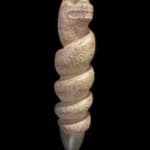Olmec Stone Rod Depicting a Jaguar-Headed Snake, 900 BCE - 300 CE
Stone
15.25
PF.6188
Further images
Considered to be the mother culture of Mesoamerican civilizations, the Olmec ruled a vast empire covering much of southern Mexico from around 1300-400 B.C. Today, they are famed for their...
Considered to be the mother culture of Mesoamerican civilizations, the Olmec ruled a vast empire covering much of southern Mexico from around 1300-400 B.C. Today, they are famed for their colossal heads, giant sculptures that first alerted scholars to their existence in the latter half of the 19th Century. Scholars continue to debate whether these monumental sculptures depict the heads of rulers and kings or decapitated sacrificial victims. Thus, when the meaning of the most well-known monuments of the Olmec culture is open to debate, little can be known for sure about these mysterious people.
The mystery of the Olmec civilization is certainly reiterated in this unusual stone sculpture. The body of a jaguar-headed snake is coiled around a short staff that terminates in a conical point. Might it served as a marker of some sorts, driven into the ground? Perhaps it alerted travelers as to the destination of a certain path. Perhaps it delineated a boundary in a primitive version of the Mesoamerican ballgame. Interestingly, if this work was inverted, other Olmec sculptures depict human figures carrying such a pointed object. Naturally, scholars debate the meaning of this object; some identifying it as a torch, in which case its relevance to this particular piece would be void. Clearly, though, it is highly likely that this stone sculpture may have served as a ceremonial staff. Remnants of cinnabar, a sacred material, are evident along the pitted surface. Our hands fit comfortably in between the grooves of the coiled serpent’s body. It is a substantial, powerful piece that would surely embody the strength of the king or shaman who might have brandished it in a religious ritual. Although we can only speculate as to the meaning of this work, we can easily appreciate its beauty and delight in its fantastical charm.
The mystery of the Olmec civilization is certainly reiterated in this unusual stone sculpture. The body of a jaguar-headed snake is coiled around a short staff that terminates in a conical point. Might it served as a marker of some sorts, driven into the ground? Perhaps it alerted travelers as to the destination of a certain path. Perhaps it delineated a boundary in a primitive version of the Mesoamerican ballgame. Interestingly, if this work was inverted, other Olmec sculptures depict human figures carrying such a pointed object. Naturally, scholars debate the meaning of this object; some identifying it as a torch, in which case its relevance to this particular piece would be void. Clearly, though, it is highly likely that this stone sculpture may have served as a ceremonial staff. Remnants of cinnabar, a sacred material, are evident along the pitted surface. Our hands fit comfortably in between the grooves of the coiled serpent’s body. It is a substantial, powerful piece that would surely embody the strength of the king or shaman who might have brandished it in a religious ritual. Although we can only speculate as to the meaning of this work, we can easily appreciate its beauty and delight in its fantastical charm.







